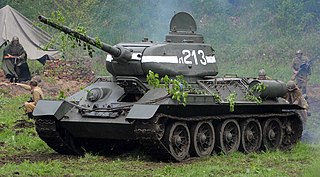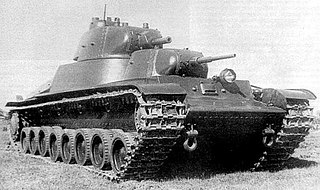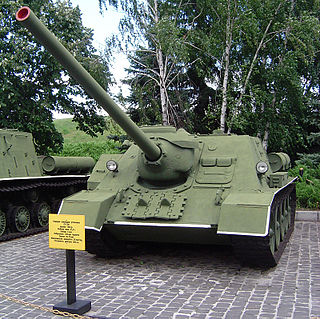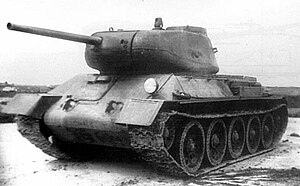History
The T-34 medium tank was the mainstay of Soviet mechanized forces in World War II, produced in huge numbers. In May 1942, Soviet forces started encountering German tanks armed with the new long 75mm KwK 40 gun which could easily penetrate a T-34 at long range.
In June 1942, the Soviet Main Directorate of Armoured Forces (GABTU) issued a requirement to two tank-design bureaus to compete in designing a "universal tank", which would combine the heavy armour of heavy tanks with the mobility of the T-34 medium tank. The SKB-2 heavy tank design bureau in Chelyabinsk started the KV-13 program, which two years later resulted in a line of successful Iosif Stalin heavy tanks. The Uralvagonzavod complex in Nizhny Tagil developed the T-43 medium tank. Uralvagonzavod included the Morozov Design Bureau, the designers of T-34, who were able to draw on its previous work on the advanced T-34M project. T-34M had been cancelled in 1941, when Germany invaded the USSR. The T-43 project received low priority, as the primary focus was on increasing production of the T-34.
The first prototype T-43 was completed in March 1943. The T-43 was generally similar to the T-34, but had a new armour layout and turret design, a space-efficient torsion bar suspension instead of the T-34's Christie type, and a new five-speed gearbox. It also featured a three-man turret with commander's cupola for all-round vision, a major improvement on the T-34's two-man turret in which the tank commander was constantly distracted with reloading the main gun. Compared to the T-34 Model 1943 with hexagonal turret, the T-43's turret armour was increased from 70 mm to 90 mm, hull from 47 mm front and 60 mm sides to 75 mm. It retained the same 76.2 mm F-34 tank gun and, for ease of production, shared at least seventy percent of its parts interchangeably with the T-34. Testing at Kubinka showed that the heavier T-43 couldn't match the T-34's mobility, while its armour was still not heavy enough to stop the German 88mm gun.
After the Battle of Kursk, Soviet planners realized that the T-34's biggest drawback was the ineffectiveness of its 76.2mm gun against the frontal armour of the new German Tiger and Panther tanks. What was needed was a more effective gun rather than heavier armour. The T-43 turret was adapted to mount a more effective 85 mm gun, and to fit on the T-34 tank hull. The T-43 project was cancelled, and the new T-34-85 was put into production instead.
The decision to improve on an existing design rather than commit to a major retooling of the factories was characteristic of Soviet philosophy which held enormous production level as paramount. While Germany — having at the time almost double the industrial resources of the Soviet Union — suffered a string of production and logistical difficulties while introducing new, technically superior tank models, the Soviets — maximizing productivity — accepted a compromise by significantly improving their main tank. The result was that the Soviets were producing T-34-85 tanks at a rate of 1,200 per month, while Germany was struggling to put 180 Panther tanks per month out of the assembly lines.
When the T-34-85 first appeared in combat, German intelligence initially misidentified it as the "T-43", based on reports about Soviet tank research.

The T-34 is a Soviet medium tank from World War II. When introduced, its 76.2 mm (3 in) tank gun was more powerful than its contemporaries, and its 60-degree sloped armour provided good protection against anti-tank weapons. The T-34 had a profound effect on the conflict on the Eastern Front, and had a long-lasting impact on tank design. The tank was praised by multiple German generals when encountered during Operation Barbarossa, although its armour and armament were surpassed later in the war. Though, its main strength was its cost and production time, meaning that German panzer forces would often fight against Soviet tank forces several times their size. The T-34 is also a critical part of the mechanized divisions that form the backbone of the Deep Battle Strategy.

The IS tanks were a series of heavy tanks developed as a successor to the KV-series by the Soviet Union during World War II. The IS acronym is the anglicized initialism of Joseph Stalin. The heavy tanks were designed as a response to the capture of a German Tiger I in 1943. They were mainly designed as breakthrough tanks, firing a heavy high-explosive shell that was useful against entrenchments and bunkers. The IS-2 went into service in April 1944 and was used as a spearhead by the Red Army in the final stage of the Battle of Berlin. The IS-3 served on the Chinese-Soviet border, the Hungarian Revolution, the Prague Spring and on both sides of the Six-Day War. The series eventually culminated in the T-10 heavy tank.

The Kliment Voroshilov (KV) tanks are a series of Soviet heavy tanks named after the Soviet defence commissar and politician Kliment Voroshilov who operated with the Red Army during World War II. The KV tanks were known for their heavy armour protection during the early stages of the war, especially during the first year of the German invasion of the Soviet Union. In certain situations, even a single KV-1 or KV-2 supported by infantry could halt German formations. The German Wehrmacht at that time rarely deployed its tanks against KVs, as their own armament was too poor to deal with the "Russischer Koloss" – "Russian Colossus".

The T-28 was a Soviet multi-turreted medium tank. The prototype was completed in 1931, and production began in late 1932. It was an infantry support tank intended to break through fortified defences. The T-28 was designed to complement the heavier T-35, with which it shared turret designs. The type did not have great success in combat, but it played an important role as a development project for Soviet tank designers. A series of new ideas and solutions that were tried out on the T-28 were later incorporated in future models.

A BT tank was one of a series of Soviet light tanks produced in large numbers between 1932 and 1941. They were lightly armoured, but reasonably well-armed for their time, and had the best mobility of all contemporary tanks. The BT tanks were known by the nickname Betka from the acronym, or by its diminutive Betushka. The successor of the BT tanks was the famous T-34 medium tank, introduced in 1940, which would replace all of the Soviet fast tanks, infantry tanks, and medium tanks in service.

The Panzerkampfwagen III, commonly known as the Panzer III, was a medium tank developed in the 1930s by Germany, and was used extensively in World War II. The official German ordnance designation was Sd.Kfz. 141. It was intended to fight other armoured fighting vehicles and serve alongside and support the similar Panzer IV, which was originally designed for infantry support.

Soviet armoured fighting vehicle production during World War II from the start of the German invasion of the Soviet Union on 22 June 1941 was large. Although the Soviet Union had a large force of combat vehicles before the German invasion, heavy losses led to a high demand for new vehicles. Production was complicated by the loss of production facilities in the western part of the Soviet Union, and entire factories were moved east of the Ural Mountains to put them out of reach of the Germans. In general, Soviet tanks had less interior space than the tanks of other nations – this was possible because the Red Army only employed soldiers of small stature in their tank forces.

The SU-85 was a Soviet self-propelled gun used during World War II, based on the chassis of the T-34 medium tank. Earlier Soviet self-propelled guns were meant to serve as either assault guns, such as the SU-122, or as tank destroyers; the SU-85 fell into the latter category. The designation "85" means the bore of the vehicle's armament, the 85 mm D-5T gun.

The Panther tank, officially Panzerkampfwagen V Panther with ordnance inventory designation: Sd.Kfz. 171, is a German medium tank of World War II. It was used on the Eastern and Western Fronts from mid-1943 to the end of the war in May 1945.

The T-44 was a medium tank first developed and produced near the end of World War II by the Soviet Union. It was the successor to the T-34, offering an improved ride and cross-country performance, along with much greater armor. Designed to be equipped with an 85 mm main gun, by the time it was fully tested the T-34 had also moved to this weapon. Both tanks offered similar performance, so introducing the T-44 was not considered as important as increasing T-34 production. Fewer than 2,000 T-44s were built, compared to about 58,000 T-34s. Although the T-44 was available by the end of the war, it was not used in any battle. It was 1 ton lighter than the T-34-85 and slightly faster. The T-44 was heavily influential on the design of the T-54/55 main battle tank, most notably the removal of side sloping, thick frontal armor, and a low profile. Also notable was the T-44-100, a 100mm D-10T-armed prototype, which would be the same 100mm gun mounted on the T-54/55, bar some minor changes.

The T-50 was a light infantry tank built by the Soviet Union at the beginning of World War II. The design for this vehicle had some advanced features, but was complicated and expensive, and only a short production run of 69 tanks was completed.

The 76 mm tank gun M1940 F-34 was a 76.2 mm Soviet tank gun used on the T-34/76 tank. A modified version of the gun, the 76 mm tank gun M1941 ZiS-5, was used on KV-1 tanks during World War II. Nowadays, the two versions are often referred to just by their factory designations, as "F-34" and "ZiS-5", respectively.

The KV-13 was an experimental Soviet medium tank created during World War II. It was developed on the KV-1 chassis in the SKB-2 design bureau of the Chelyabinsk Kirov Plant in late 1941 – early 1942, as a "universal" tank, intended to replace the production of T-34 medium tanks and KV-1 heavy tanks at the same time.

The 85 mm air defense gun M1939 (52-K) was an 85 mm (3.3 in) Soviet anti-aircraft gun, developed under guidance of leading Soviet designers M. N. Loginov and G. D. Dorokhin. This gun was successfully used throughout the Second World War against level bombers and other high- and medium-altitude targets. In emergencies they were utilized as powerful anti-tank weapons. The barrel of the 52-K was the basis for the family of 85-mm Soviet tank guns. After the war some 52-Ks were refitted for peaceful purposes as anti-avalanche guns in mountainous terrain.
OKMO was the tank design team in the Soviet Union during the early 1930s. Located in Leningrad, it produced the design of the T-26 infantry tank, of which about 12,000 would be produced. Most other designs from the bureau never saw the light of day, but it was here that Mikhail Koshkin, designer of the famous T-34 medium tank gained his early experience. The bureau was gutted in the Great Purge and broken up by the beginning of the Second World War.

The T-100 was a Soviet twin-turreted heavy tank prototype, designed in 1938–39 as a possible replacement for the T-35 heavy tank. The T-100 was designed by N. Barykov's OKMO design team at S.M. Kirov Factory No. 185 in Leningrad. The T-100 was originally conceived with three turrets and was eventually built with two. It was in competition with a similar design - the SMK - but neither were adopted and instead a single turret version of the SMK was ordered as the KV-1. All three prototypes were tested at the same time in the Battle of Summa during the Winter War with Finland.

The D-10 is a Soviet 100 mm tank gun developed in late World War II. It originally equipped the SU-100 tank destroyers and was later selected for the T-55 tank, equipping these as late as 1979. On the T-55 the D-10 continues to be in active service in many countries.

The L-11 76.2 mm tank gun was a Soviet tank gun, used on the earliest models of the T-34 Model 1940 medium tank and KV-1 Model 1939 heavy tank during World War II.

The Tiger I was a German heavy tank of World War II that began operational duty in 1942 in Africa and in the Soviet Union, usually in independent heavy tank battalions. It gave the German Army its first armoured fighting vehicle that mounted the 8.8 cm KwK 36 gun. 1,347 were built between August 1942 and August 1944. After August 1944, production of the Tiger I was phased out in favour of the Tiger II.

The IS-2 is a Soviet heavy tank, the second of the IS tank series named after the Soviet leader Joseph Stalin. It was developed and saw combat during World War II and saw service in other Soviet allied countries after the war.




















